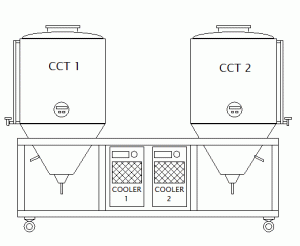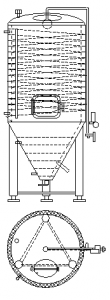Technology for the fermentation and maturation process
Fermentation and maturation process – a secondary phase of the beer production
The brewing of hot wort which is the first phase of the production cycle of beer, is followed by a second phase, called the fermentation. Fermenting of wort is a manifestation of metabolism of brewer yeast. Yeast is added into wort after its aeration immediately after wort is cooled to the fermentation temperature after wort is pumped from the brewhouse to fermentation vessels.
The main task of brewer yeast in the primary fermentation stage is to convert part of the sugars in the wort into alcohol. At the set degree of fermentation the fermentation process is interrupted (not to be the full conversion of 100 % sugar). The so-called young or green beer is pumped into another tank wherein continuing fermentation process has a lower intensity, but it takes place at a lower temperature and higher pressure while the beer is carbonated by carbon dioxide. This part of the fermentation process is called the maturation of beer – the secondary fermentation.
Two main beer fermentation technologies
Design and construction of tanks for the primary beer fermentation varies depending on the technology. In our craft breweries we use both most common fermentation technologies which can be used within one brewery also in their combinations and this allows to produce beer of different kinds and sensory properties.
I. The bottom fermentation of beer
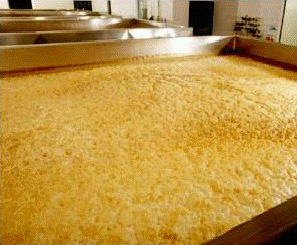 The style of bottom-fermenting includes all bottom-fermented beers using the Saccharomyces uvarum yeast. The majority of world production are bottom-fermented beers, including Czech lager Pilsner. These include for example also Dortmunder, Bock, Marzen and more beers called lagers.
The style of bottom-fermenting includes all bottom-fermented beers using the Saccharomyces uvarum yeast. The majority of world production are bottom-fermented beers, including Czech lager Pilsner. These include for example also Dortmunder, Bock, Marzen and more beers called lagers.
The bottom yeast fermentation is carried out at temperatures of 6-12 ° C and lasts for 6-12 days. Beer lies for a month or longer (from here the name “lager”) at low temperature which ensure, among other things, the dispersion of sulfur compounds created during primary fermentation.
The technology of open fermentation in open fermentation vats in the fermentation room is typical mainly for production of beer using the bottom yeast. It allows especially convenient collection of brown foam from the dead yeast in the last stage of the fermentation which is a prerequisite for making a quality lager of traditional taste. Unfortunately the open fermentation technology is absolutely unsuitable for the production of top-fermented beer since the access of air to the active yeast on surfac of the fermented wort often tends to result in the contamination of beer by undesirable organisms.
For small breweries, there is a strong argument for the main beer fermentation in open vats – the great marketing asset. A view of the beer in the fermentation phase with many colour of the yeast foam is one of the main attractions for all visitors of the craft brewery.
Scheme of the brewery with the open fermentation technology :
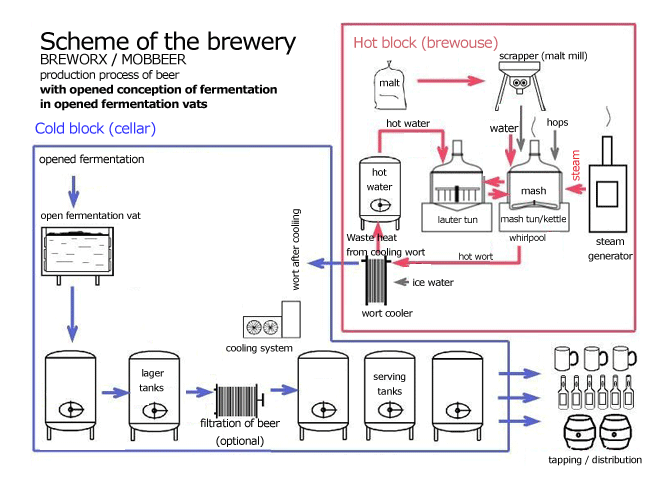
In modern breweries mainly the cylindrically-conical tanks are used for both bottom and top fermentation of beer. Although the quality of bottom-fermented beer from closed tank does not reach the quality of beer fermenting in open containers, the economic benefit is the decisive reason for the abandonment of traditional fermentation technology in other than small breweries.
II. The top fermentation of beer
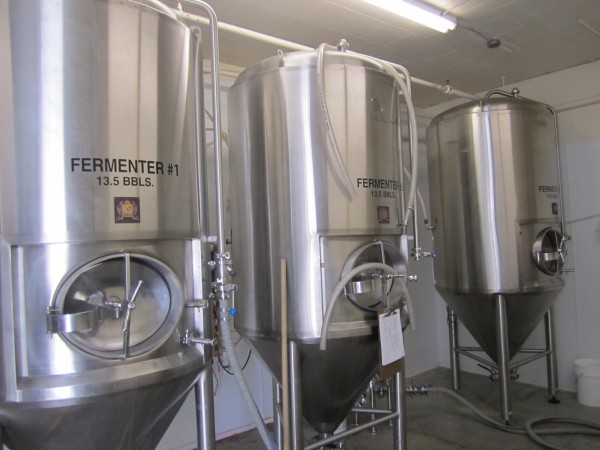 The beer style based on top fermentation includes all beers which used Saccharomyces pastorianus yeast. This style includes beers like Ale, Porter, Stout, Altbier, Trappist or wheat beer. Top fermentation process is carried out at temperatures of 15-24 ° C and usualy lasts 3-9 days.
The beer style based on top fermentation includes all beers which used Saccharomyces pastorianus yeast. This style includes beers like Ale, Porter, Stout, Altbier, Trappist or wheat beer. Top fermentation process is carried out at temperatures of 15-24 ° C and usualy lasts 3-9 days.
In most cases, on the surface of fermenting beer there floates a foam caused by rising carbon dioxide together with active yeast. That is why these beers are called on-top fermented beers. The primary fermentation of these beers takes usually around three weeks, in some cases it may maturate for several months. Yeast clusters are grouped in colonies (they may have a diameter of several meters), live on the surface of wort and they produce carbon dioxide. Higher fermentation temperature causes more floweriness of final beer. On-top fermenting beers vary in flavours and we often can find exotic aromas in them (cloves, banana, grep, etc..), although the brewer did not add such ingredients to the beer. All this is caused by the top fermentation.
The best type of fermentation vessels for bottom fermentation is closed cylindrically-conical tank. The main reason for closed fermentation in tanks is susceptibility of top-fermented beer to contamination yeast foams by foreign organisms from the environment around. Another reason is the possibility of controlled fermentation and maturation of beer in one universal fermentor and easy cleaning and sanitization of all closed tanks.
Scheme of the brewery with the closed fermentation technology :

How to calculate the size and number of fermentation vessels
1. Calculation the size of fermenters
The main indicator that determines the useful volume of fermentation vessels is planned daily production volume of wort. This means the volume of wort, which we brew within 24 hours in one brew day. We usualy do not brew wort every day – at least one day of the week is done sanitation of the brewhouse.
Rule: We choose the next near higher volume of fermentation vessels depending on the volume of daily batch of wort.
Example: We plan to produce three batches of wort during one brewing day in the brewhouse with volume of 2.5 HL. 3 x 2.5 = 4.5 HL. We need fermentation vessel with a volume of at least 4.5 HL. We do not have the container with a volume of 4.5 HL in the type series, therefore we choose a container with a volume of 5 HL.
The calculated effective volume of fermentation vessels is both for the main fermentation and maturation of beer, since we always pump the entire volume of the primary fermenter into one secondary fermentation vessel.
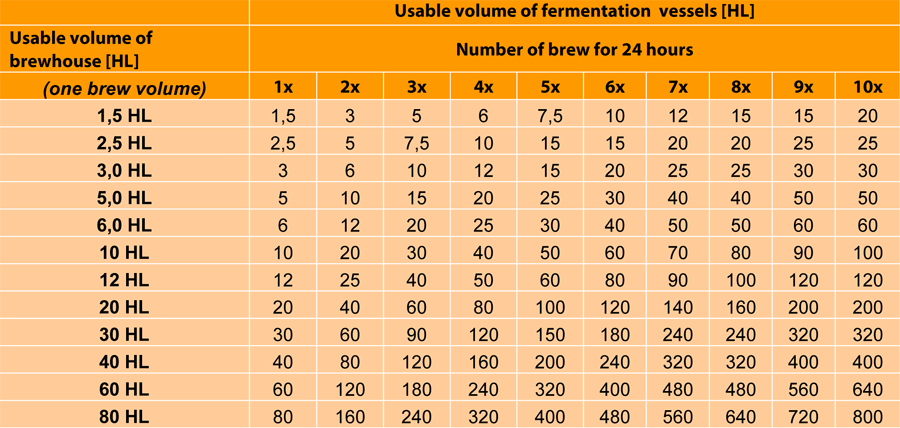
2. Calculation the number of fermenters
Among the indicators that determine the number of fermentation tanks for primary fermentation, there are the time of main fermentation of the daily batch of wort,and a number of brew days that will take place within this time .
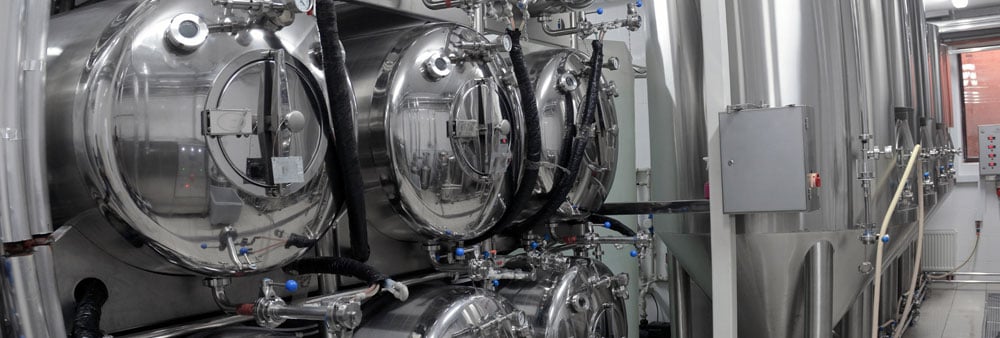
Rule : The number of containers for the main fermentation must be at least as high as how many days the brewing takes place during one period of the main fermentation . The types of fermentation vessels are chosen according to the type of fermentation of selected beers (CCT cylindrically-conical tanks or OFV open fermentation vats for all on-bottom fermented beers or CCT for all on-top fermented beers).
Example : We plan to produce 1x weekly on-top-fermented beer with main fermentation time 6 days and twice a week bottom-fermented beer with main fermentation time of 12 days. It follows that we need only one fermentation vessel for the first beer because we plan only one brew day during 6 days of its fermentation time. In contrast, while making the second beer there are four brewing days during 12 days of the fermentation time, so we need 4 pcs of fermentation vessels. For the first beer we need either cylidrically-conical tanks (CCT) or open fermentation vats (OFV). For the second beer we have to choose only the cylidrically-conical tanks (CCT) because this type of beer is not recommended to be fermented in the open container. Altogether our brewery needs 5 pcs of fermentation vessels for main fermentation with the volume coounted according the previous text. The recommended portfolio of the fermentors for the primary fermentation will be: 1 pc of OFV + 4 pcs of CCTs or 5 pcs of CCTs for both beers.
Note: The recommended duration of fermentation is the main part of each recipe for a selected type of beer. Yet the real time of the main fermentation can be one two days more or less, which is due to a number of factors, such as vitality of the yeast, the quality of malt, atmospheric pressure, ambient temperature and other influences. In reality for each batch only the main brewer decides on the termination of the primary fermentation according to measurement results of fermented extract by hydrometer. For the above reasons, we recommend to calculate the time of the main fermentation by at least two days longer than the recipe states. In practice this usually means we recommend to have one more fermentation container in the brewery as a reserve. Ignoring this recommendation may cause result in a lack of fermentation containers and reducing the planned production capacity.
[table id=13 /]
Calculation number and types fermentors for the secondary beer fermentation – maturation
Among the indicators that determine the number, size and type of containers for beer maturation, there are the recommended maturation periods (lying) of produced beer, the brewing daily volume of wort and the number of days that takes place during this period.
Rule: The number of containers for beer maturation in a brewery has to be at least as high as to allow the to place in the tanks all batches of beer that maturate in the same time.
The type and shape of maturation vessels is not very important, but they must be able to keep beer during the maturation under the set pressure using a pressure adjusting facility. They are cylindrically-conical tanks, vertical maturation cylindrical tanks and horizontal maturation tanks. All these tanks are different types of beer production tanks, which are used in second or both phases of the beer production cycle.
Example : We plan to produce once a week on-top-fermented beer with a suggested maturation period of three weeks and twice a week on-bottom-fermented beer with a recommended period of maturation nine weeks. It means that for the first beer you need 3 pcs of maturation tanks for simultaneous maturation of all batches, for the second beer 18 pcs of maturation tanks (2 x 9). Therefore the total need of fermentors for the beer maturation in the brewery is 3 +18 = 21 pcs of the beer maturation tanks.
Note : For special strong beers it is recommended to have beer maturation time of several months. To equip the brewery with maturation vessels for strong beers implies the need for extremely high amounts of maturation tanks in the brewery. This is not normally needed because the demand for strong beers in restaurants is usually not that big. In practice this extreme is solved in winter, when beer consumption with a lower alcohol content declines, the maturation tanks reserved for the basic assortment can be used (brewing schedule is temporarily reduced to the half of production volume) to produce special beers with more procentes of alcohol, while the maturation process takes place in tanks only as long as necessary for a few weeks, when it is not needed to use them for the usual summer assortment of light beers. Special beer is filled into stainless steel kegs stored in cold room, where maturation process continues. Therefore the empty maturation tanks are available for new batches of beer. Due to the long lifetime of beers with more procentes of alcohol it is possible to offer these winter specials from kegs during all remainder of the year, when the maturation tanks are used for production of usual assortment of weaker beers.
[table id=14 /]
Technical parameters and descriptions of fermentors for the primary and secondary beer fermentation – maturation:
OFT : Open fermentation vats
The technology of open fermentation in open fermentation vats in the dedicated fermentation room is typical mainly for production of the bottom fermented beers. The construction of the open fermentors allows especially convenient collection of foam from the dead yeast in the last stage of the primary fermentation which is a prerequisite for making a quality bottom fermented beer of traditional taste. This type of fermentors is typical mainly for Czech craft breweries.
Open technology is unsuitable for the production of top-fermented beer since the access of air to the live yeast active on the surface of the fermenting wort often tends to result in the contamination by undesirable organisms. This type of the beer fermentor is recommended for production of Czech lager Pilsner but also for other types of lagers, for example, Dortmunder, Beck, Marzen.
FUIC : Compact beer fermentation units
– pressure cylindrically-conical tanks for the secondary fermentation of beer/cider built in the compact modules :
FUIC – The compact fermentation units – the compact independent mobile devices with one up to four cylindrically-conical tanks which include all equipment that is needed for the primary fermentation of beer or cider, maturation and carbonation process under pressure, filling of carbonated beverage into kegs or bottles.
Compact fermentation units consist of these main components :
- 1 pc up to 4 pcs of the CCT/CCF fermentor – stainless steel tanks with PUR insulation, cooled by water or polypropylenglycol solution
- 1-4 pcs of the compact water cooling unit
- Elements for the measurement and control of temperature and to circulation of coolant through cooling jacket of the tanks
- Elements for the connections between cooler and fermentors
- Common stainless steel frame with adjustable legs and optionaly with the possibility of moving on wheels
CCT/CCF : Cylindrically-conical fermentation tanks
– pressure cylindrically-conical tanks for the secondary fermentation of beer/cider :
The technology of the beer fermentation in closed cylindrically-conical fermentation tanks is characteristic for a modern method of the beer production.
It especially allows the safe production of top-fermented beer but it is also used for the production of all beer types based on yeast with bottom fermentation.
The advantage of these fermentors is the possibility of both phases of the beer fermentation in the same tank. Fermentation and maturation of beer in the CCT fermentors under pressure not only speeds up the fermentation process, but allows to manage the entire machine fermentation and maturation process without pumping beer between two vessels as well. The only disadvantage in comparation with the open fermentation vats is the impossibility to collect the foam with dead yeast after the primary fermentation.
We manufacture the cylindrically-conical fermentation tanks without insulation or with PUR insulation, equipped with two and more cooling zones , cooled by water or polypropylenglycol. They can be used either only for the main fermentation, or for both the main fermentation and subsequent maturation of beer in the same tank.
Equipment of the CCT fermentors can be defined by customer or you can purchase the tanks with our standardly recomended accessories.
MBT : Cylindrical fermentation tanks
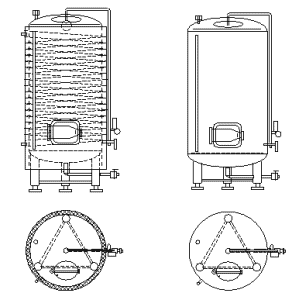 – pressure tanks for the secondary fermentation of beer/cider in four variants :
– pressure tanks for the secondary fermentation of beer/cider in four variants :
-
MBTVI – Maturation tanks vertical, insulated, liquid-cooled
-
MBTVN – Maturation tanks vertical, non-insulated, air-cooled
-
MBTHI – Maturation tanks horizontal, insulated, liquid-cooled
-
MBTHN – Maturation tanks horizontal, non-insulated, air-cooled
The primary beer fermentation process follows the secondary process of the maturation of beer in the maturation tanks (also called the lager tanks). During this production phase, the beer matures and saturates itself with the carbon dioxide, which is formed by the remaining yeast activity. This way the beer acquires the final savour. We produce the maturation tanks in four variants – insulated, liquid cooled, or non-insulated, air cooled. We offer the pressure beer maturation vessels with the fermentation apparatus which allows the adjustable pressure in the tank up to 3.0bar.
CCTM : Modular cylindrically-conical fermentors
Modular cylindrically-conical fermentors – The CCTM are very versatile products from our own production portfolio which enable you to arbitrarily assemble the fermentor for the production of beer/cider/wine in currently required configuration.
The configuration of the fermentation tank can be changed at any time, even during full operation when the tank is pressurized and just filled with a beverage within its fermentation of maturation. It is not possible to reach this with other type of fermentors. This possibility saves your costs because you need only several universal tanks for more phases of the beverage production process.
![]()
